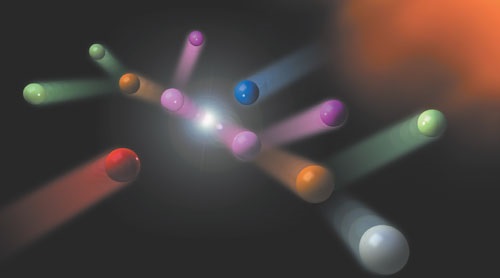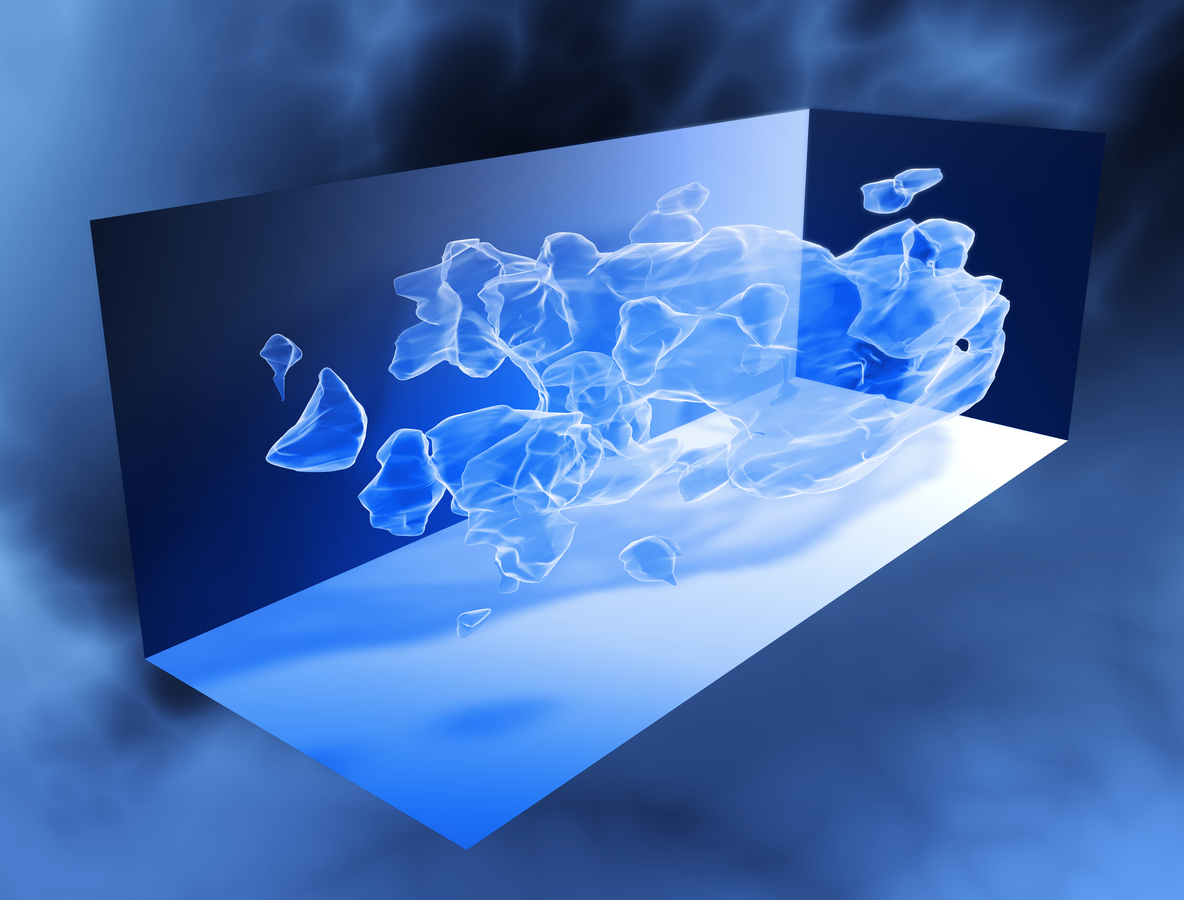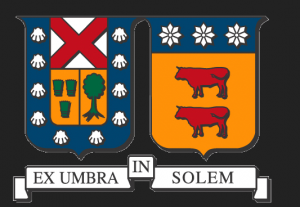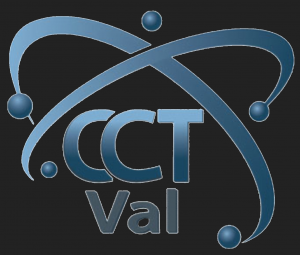Beyond the Standard Model physics

Composite Higgs and Spin-‐1 Resonances
The recent discovery of the Higgs boson at the LHC [1, 2] provides the opportunity of directly exploring the mechanism responsible for the Electroweak Symmetry breaking. At the same time, this remarkable achievement implies severe constrains on many proposed extensions of the Standard Model. However, an additional sector beyond our current knowledgeis still needed in order to explain the dynamical origin of the electroweak scale and its stability. An important associated question is whether this eventual new sector is weakly or strongly interacting. In the latter case, the Higgs boson is viewed as a composite state, which must be accompanied by a plethora of new heavy composite particles. In general, it is expected the lightest states produced by the strong dynamics correspond to spin-‐0 and spin-‐1 particles. A composite Higgs boson scenario is theoretically attractive because the underlying strong dynamics pro-‐ vides a comprehensive and natural explanation for the origin of the Fermi scale. However, the presence of the already mentioned additional composite states may, in principle, produce phenomenological problems. For instance one could expect that, at one loop level, they may produce sensible corrections to observables involving the Higgs boson.
Our group has already studied this scenario using an Effective Lagrangian approach [3, 4, 5, 6]. For this project, we propose to study the phenomenology of the different spin-‐0 and spin-‐1 resonances using, the so-‐called Linear Bess Model [7,8]. This model, although old, has never been studied in the context of LHC data and, being a very minimal but at the same time realistic realization of the composite sector, can be used as a benchmark. Additionally, it exhibits a decoupling property, which guarantees consistency with present precision measurements. This model will be used to set limit on the masses and couplings of the composite particles by comparing our predictions with ATLAS results.

P-P Collision at LHC where 4 high energy electrons can be seen (green and red lines)
New spin-‐1 matter fields and Dark Matter
Our interest on composite vector states is part of a broader program of studying new spin-‐1 fields. Recently, we found that Yang-‐Mills theory can be consistently extended by inclusion of extra massive vector fields that play the role of matter fields [9].
The only condition for the theory to be consistent is that the Lagrangian must respect a Z2 symmetry under which the new vector field is odd. Interestingly, this property makes the new spin-‐1 particle stable. We propose to construct an extension of the Standard Model that incorporate this idea in theSU(2)L sector.
This model will contain a stable massive neutral spin-‐1 particle that may be a dark matter candidate. In this project we will study the limits on the model parameters coming from LHC data and dark matter searches.

Reconstruction of 3D map of the large-scale distribution of dark matter using measurements of weak gravitational lensing from the Hubble Space Telescope.
Neutrino Physics at LHC

The Large Hadron Collider (LHC), CERN. Switzerland
- Probing the Majorana nature of neutrino.
Neutrinos are probably the most mysterious particles we know. They are believed tobe a portal to new physics beyond the Standard Model of the electro-‐weak interactions. Neutrinos are the only fermions, which could be identical to their antiparticles leading to Lepton Number Violation (LNV) conservation. If so, neutrinos are Majorana particles in contrast to all other known fermions, which are Dirac ones. Usually neutrinoless double beta decay is considered to be the only practical way to test whether neutrinos are particles of Majorana nature. However, in case LNV occurs around the electro-‐weak scale, experiments at the LHC have a chance to discover a LNV signal and answer decisively the fundamental question about the nature of neutrinos, if they are Majorana or Dirac particles. Here we propose new LNV searches at LHC associated with three different kinds of LNV mechanisms.
- LNV with Leptoquark at LHC.
Leptoquark (LQ) models has been widely studied in the literature (See for instance [10,11,12]). In particular, in [13,14] it is shown that LQ models coming from tree-‐level high-‐energy completions of lepton number violation operators that generate neutrinoless double beta decay lead to LNV signals at LHC. Here we will focus in a class of LQ mechanisms, which assume at leastone new Leptoquark boson and one color fermion, both with masses at the TeV scale. These mechanism can produce a neutrinoless double beta decay signal (see [13,14]) and at LHC may be searched through the pair production of color fermion providing same sign dilepton signals with 4 jets and even 8 jets depending on the mechanism.
- Neutrinoless double beta decay at the LHC:
We will examine the reach of the LHC experiments for LNV signals in the forthcoming 14 TeV run an compare it to the sensitivity of current and the next generation double beta decay experiments, assuming at least two new heavy boson, both with masses at the TeV scale.
These are the so-‐called topology II mechanisms for double beta decay according to the notation of Refs. [13,14]. Moreover we will study the hypothetical situation, when a positive LNV signal is found at the LHC, then the question will be if it is possible to identify some details of its fundamental origin as well as to pin down the dominant underlying mechanism of neutrinoless double beta decay.
- Neutrino masses and LNV signals at LHC.
Neutrino oscillation experiments have shown conclusively that neutrinos are massive, very light, particles mixing with each other, although the mechanism responsible to give mass to neutrinos is still unknown and difficult to determine from low-‐energy phenomenology. We will focus on the possibility of obtaining indirect information about neutrino mass generation mechanism from same dilepton plus 2 jets signal at LHC. For this propose we will study a 2-‐loop neutrino mass mechanisms with diquarks as a benchmark model, which gives different discriminants than the usual Left Right symmetric search [15] (See also [16]). The complete list of 2-‐loop neutrino mass models, which lead to dilepton plus 2 jets signal, is given in [17].
Recently we came up with the concrete proposal for the ATLAS collaboration to make dedicated studies of the above-‐mentioned signatures in the next runs of the LHC. Currently we are carrying out the corresponding numerical simulations for the ATLAS detector for the 14TeV high luminosity phase of LHC. (Juan Carlos Helo, Martin Hirsch, S. Kovalenko)
- Radiative neutrino mass and double charged scalarsat the LHC
We will also study some other non-‐supersymmetric extensions of the Standard Model, where neutrino masses and mixing angle are generated radiatively [18]. Simple realizations of this mechanism are the Zee [19], Zee-‐Babu model [20], as well as [21]. The ultraviolet completions of the dimension 7 and dimension 9 lepton number violation effective operators [22] (among others higher dimension effective LNV effective operators), involve double charged scalars fields, among other charged and non-‐ charged scalars. These classes of models proved a natural non-‐trivial way to generate neutrino mass and mixing, as well as WIMPs Dark Matter candidates [23] simultaneously from the scalar sector of the model. The masses of double charged particles must be around the TeV [24] by the neutrino oscillation data fit [25], given an unbeatable way to explore the validity of this class of model at the LHC exploring the phenomenology of the double charged scalar decay and production. This can help to constrain or reject these classes of model, contributing to the understanding the Neutrino and Dark Matter physics from the collider physics point of view. New perspectives in this direction we expect from 14 TeV high luminosity LHC phase.
References
[1] G. Aad et al. [The ATLAS Collaboration], Phys. Lett. B716, 1 (2012) [arXiv:hep-‐ex/1207.7214].
[2] S. Chatrchyan et al. [The CMS Collaboration], Phys. Lett. B716, 30 (2012) [arXiv:hep-‐ ex/1207.7235].
[3] A. R. Zerwekh, Eur. Phys. J. C 46 (2006) 791 [arXiv:hep-‐ph/0512261].
[4] A. R. Zerwekh, Mod. Phys. Lett. A A25 (2010), 423 [arXiv:hep-‐ ph/0907.4690].
[5] O. Castillo-‐Felisola, C. Corral, M. Gonzlez, G. Moreno, N. A. Neill, F. Ro-‐ jas, J. Zamora and A. R. Zerwekh, Eur. Phys. J. C 73, 2669 (2013) [arXiv:1308.1825 [hep-‐ph]].
[6] A. E. Carcamo Hernandez, C. O. Dib and A. R. Zerwekh, Eur. Phys. J. C74, 2822 (2014)
[7] R. Casalbuoni, S. De Curtis, D. Dominici and M. Grazzini, Phys. Lett. B388, 112 (1996) [hep-‐ ph/9607276].
[8] R. Casalbuoni, S. De Curtis, D. Dominici and M. Grazzini, Phys. Rev. D56, 5731 (1997) [hep-‐ ph/9704229].
[9] A. R. Zerwekh, Int. J. Mod. Phys. A28, 1350054 (2013) [arXiv:1207.5233 [hep-‐ph]].
[10] W. Buchmüller, R. Rückl, and D. Wyler, Phys. Lett. B191, 442 (1987).
[11] Aristizabal, Hirsch, Kovalenko. Phys.Rev. D77 (2008) 055011.
[12] Hirsch, Klapdor-‐Kleingrothaus Kovalenko. Phys.Rev. D54 (1996) 4207-‐4210.
[13] Helo, Hirsch, Päs, Kovalenko. Phys.Rev. D88 (2013) 073011 .
[14] Helo, Hirsch, Päs, Kovalenko. Phys.Rev. D88 (2013) 1, 011901.
[15] ATLAS Collaboration, G. Aad et al., Eur.Phys.J. C72, 2056 (2012). [arXiv:1203.5420]
[16] Helo, Hirsch, Kovalenko. Phys.Rev. D89 (2014) 073005.
[17] Dos Santos, Helo, Hirsch, Ota. To appear soon.
[18] R. Barbieri, L. J. Hall, V. S. Rychkov, Phys. Rev. D74, 015007 (2006); E. Ma, Phys. Rev. D 73, 077301 (2006); E. Ma and U. Sarkar, Phys. Lett. B 653, 288 (2007); T. Hambye and M. H. G. Tytgat, Phys. Lett. B 659, 651 (2008).
[19] A. Zee, Phys. Lett. B 93 (1980) 389 [Erratum-‐ibid. B 95 (1980) 461]; Nucl. Phys. B 264 (1986) 99.
[20] A. Zee, Nucl. Phys. B 264, 99 (1986); K. S. Babu, Phys. Lett. B 203 132 (1988).
[21] S. Nasri and S. Moussa, Mod. Phys. Lett. A 17 771 (2002); C.-‐S. Chen, C. Q. Geng and J. N. Ng, Phys. Rev. D 75 053004 (2007).
[22] F. del Aguila, A. Aparici, S. Bhattacharya, A. Santamaria and J. Wudka, JHEP 1205 (2012) 133, JHEP 1206 (2012) 146.
[23] B. W. Lee and S. Weinberg, Phys. Rev. Lett. 39, 165 (1977); G. Jungman, M. Kamionkowski and K. Griest, Phys. Rept. 267, 195 (1996).
[24] M. Gustafsson, J. M. No and M. A. Rivera, Phys. Rev. Lett. 110 (2013) 211802, M. Gustafsson, J. M. No and M. A. Rivera, Phys. Rev. D 90, 013012 (2014).
[25] D. V. Forero, M. Tortola and J. W. F. Valle, Phys. Rev. D 86, 073012 (2012); G. L. Fogli, E. Lisi, A. Mar-‐ rone, D. Montanino, A. Palazzo and A. M. Rotunno, Phys. Rev. D 86, 013012 (2012); M. C. Gonzalez-‐ Garcia, M. Maltoni, J. Salvado and T. Schwetz, JHEP 1212, 123 (2012).





